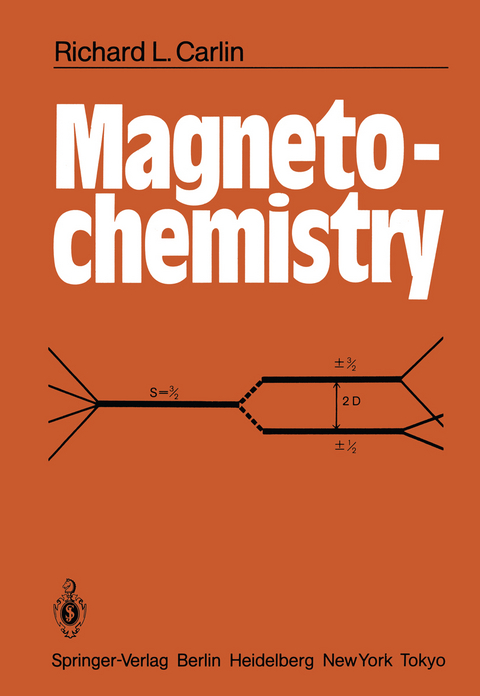
Magnetochemistry
Springer Berlin (Verlag)
978-3-642-70735-3 (ISBN)
1. Diamagnetism and Paramagnetism.- 1.1 Introduction.- 1.2 Diamagnetism.- 1.3 Atomic Term Symbols.- 1.4 Paramagnetism.- 1.5 Some Curie Law Magnets.- 1.6 Curie-Weiss Law.- 1.7 Temperature Independent Paramagnetism.- 1.8 References.- 1.9 General References.- 1.10 Appendix.- 2. Paramagnetism: Zero-Field Splittings.- 2.1 Introduction.- 2.2 Van Vleck's Equation.- 2.3 Paramagnetic Anisotropy.- 2.4 Spin-Orbit Coupling.- 2.5 Effective Spin.- 2.6 Direct Measurement of D.- 2.7 Electron Paramagnetic Resonance.- 2.8 References.- 3. Thermodynamics.- 3.1 Introduction.- 3.2 Thermodynamic Relations.- 3.3 Thermal Effects.- 3.4 Adiabatic Demagnetization.- 3.5 Schottky Anomalies.- 3.6 Spin-Lattice Relaxation.- 3.7 References.- 4. Paramagnetism and Crystalline Fields: The Iron Series Ions.- 4.1 Introduction.- 4.2 Magnetic Properties of Free Ions.- 4.3 Quenching of Orbital Angular Momentum.- 4.4 Coordination Compounds.- 4.5 Jahn-Teller Behavior.- 4.6 The Iron Series Ions.- 4.7 References.- 5. Introduction to Magnetic Exchange: Dimers and Clusters.- 5.1 Introduction.- 5.2 Energy Levels and Specific Heats.- 5.3 Magnetic Susceptibilities.- 5.4 Copper Acetate and Related Compounds.- 5.5 Some Other Dimers.- 5.6 EPR Measurements.- 5.7 Clusters.- 5.8 The Ising Model.- 5.9 References.- 6. Long-Range Order. Ferromagnetism and Antiferromagnetism.- 6.1 Introduction.- 6.2 Molecular Field Theory of Ferromagnetism.- 6.3 Thermal Effects.- 6.4 Molecular Field Theory of Antiferromagnetism.- 6.5 Ising, XY, and Heisenberg Models.- 6.6 Dipole-Dipole Interactions.- 6.7 Exchange Effects on Paramagnetic Susceptibilities.- 6.8 Superexchange.- 6.9 Field Dependent Phenomena.- 6.10 Ferromagnets.- 6.11 Ferrimagnetism.- 6.12 Canting and Weak Ferromagnetism.- 6.13 Characteristic Behavior of the 3d Ions.- 6.14References.- 7. Lower Dimensional Magnetism.- 7.1 Introduction.- 7.2 One-Dimensional or Linear Chain Systems.- 7.3 Long-Range Order.- 7.4 Alternating Linear Chains.- 7.5 Spin-Peierls Systems.- 7.6 Two-Dimensional or Planar Systems.- 7.7 CaCu(0Ac)4 · 6H20.- 7.8 Metamagnetism.- 7.9 Canting and Weak Ferromagnetism.- 7.10 Some Ferromagnetic Linear Chains.- 7.11 Solitons.- 7.12 References.- 8. The Heavy Transition Metals.- 8.1 Introduction.- 8.2 Molybdenum (III).- 8.3 Ruthenium (III).- 8.4 Rhenium (IV).- 8.5 Osmium (III).- 8.6 Iridium (IV).- 8.7 References.- 9. The Rare Earths or Lanthanides.- 9.1 Introduction.- 9.2 Cerium.- 9.3 Praseodymium.- 9.4 Neodymium.- 9.5 Samarium.- 9.6 Europium.- 9.7 Gadolinium.- 9.8 Terbium.- 9.9 Dysprosium.- 9.10 Holmium.- 9.11 Erbium.- 9.12 Thulium.- 9.13 Ytterbium.- 9.14 Some Other Systems.- 9.15 References.- 10. Selected Examples.- 10.1 Introduction.- 10.2 Hydrated Nickel Halides.- 10.3 Tris (dithiocarbamates) of Iron (III).- 10.4 Spin-3/2 Iron (III).- 10.5 Manganous Acetate Tetrahydrate.- 10.6 Polymerie NiX2L2.- 10.7 Hydrated Nickel Nitrates.- 10.8 The Pyridine N-Oxide Series.- 10.9 The A2[FeX5(H20)] Series of Antiferromagnets.- 10.10 Some Dilution Experiments.- 10.11 Biomagnetochemistry of Cobalt (II).- 10.12 References.- 11. Some Experimental Techniques.- 11.1 Introduction.- 11.2 Specific Heat Measurements.- 11.3 Gouy and Faraday Balances.- 11.4 Susceptibilities in Alternating Fields.- 11.5 Anisotropic Susceptibilities.- 11.6 References.- Formula Index.
| Erscheint lt. Verlag | 6.12.2011 |
|---|---|
| Zusatzinfo | XI, 328 p. |
| Verlagsort | Berlin |
| Sprache | englisch |
| Maße | 170 x 244 mm |
| Gewicht | 594 g |
| Themenwelt | Naturwissenschaften ► Chemie ► Anorganische Chemie |
| Naturwissenschaften ► Chemie ► Physikalische Chemie | |
| Schlagworte | Atom • chromium • Cobalt • Copper • Erbium • Europium • Holmium • Iridium • metals • Nickel • Osmium • Rhenium • Ruthenium • thermodynamics • Transition metal |
| ISBN-10 | 3-642-70735-1 / 3642707351 |
| ISBN-13 | 978-3-642-70735-3 / 9783642707353 |
| Zustand | Neuware |
| Haben Sie eine Frage zum Produkt? |
aus dem Bereich


